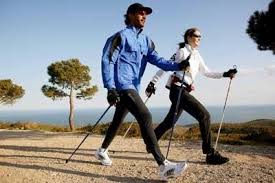 Walking is one of the easiest and most comfortable ways of incorporating exercise into your daily routine. Walking has the lowest dropout rate of any other fitness program and is relatively free. With just a comfortable pair of supportive shoes and weather-appropriate clothing you are well on your way to developing a fitness routine that will bring you health.
Walking is one of the easiest and most comfortable ways of incorporating exercise into your daily routine. Walking has the lowest dropout rate of any other fitness program and is relatively free. With just a comfortable pair of supportive shoes and weather-appropriate clothing you are well on your way to developing a fitness routine that will bring you health.
The health benefits of walking are numerous. They range from improved mood, heart and cardiovascular benefits to reduced fat and calorie burn. It’s an all around good deal for anyone. Even those who suffer from arthritis or other joint diseases can often walk for short distances. These walks will improve the muscle strength around the joints and reduce pain. Before starting any fitness program, it’s important to check with your doctor and clear the exercise based on your individual needs.
The clothes you walk in should be loose fitting and comfortable. The clothes you wear will depend upon the climate you’re walking through and the intensity you have planned.
Remember to use socks that are made of breathable material so your feet stay cool and dry. Cotton will get soaking wet and stay pressed against your feet, creating an environment for blisters and sores. Thin socks won’t provide enough cushioning. Your shoes should be comfortable, supportive and walking-specific that are lightweight and breathable. Your shoes should also have a good arch support and flexible sole. There is no one best shoe being sold, but there is a best shoe that fits your foot.
Women should also consider using a supportive sports bra. Although not as vigorous as running, walking will put some pressure on the tendon that supports the breast. A wide chest band under the breasts that is supportive but not tight will help to reduce the bounce and the discomfort.
If you aren’t wearing shorts and a t-shirt then it’s best to layer your clothing. Layering will allow you to adapt your clothing according the weather and the intensity of your workout. The harder you work, the warmer your body becomes. But walking in the cold with little clothing because your working hard will only cool your muscles off too quickly and increase your risk for injury.
Your accessories should include sunscreen whether it’s summer or winter to protect your skin. Wear a hat in the winter to protect heat loss from your head and in the summer to protect your head and face from the sun. Sunglasses will prevent UV exposure to your eyes.
If you are walking for more than 30 minutes, be sure to carry water to prevent dehydration. You can carry a bottle in a hip carrier or hide a bottle along your route.
Resources:
SparkPeople: What to Wear When You Walk
http://www.sparkpeople.com/resource/fitness_articles.asp?id=1197
StartWalkingNow American Heart Association: Proper Walking Attire
http://www.startwalkingnow.org/res_walkmore_properwalking.jsp
Walking Healthy: Women’s Travel Clothes
http://www.walkinghealthy.com/walkinghealthy/faq/Clothing.asp
WalkingFit: FAQs
http://walkingfit.ucr.edu/faq.html
Tribesports: What to Wear for Long Distance Trail Walking
http://tribesports.com/guides/what-to-wear-for-long-distance-trail-walking


Leave a Reply